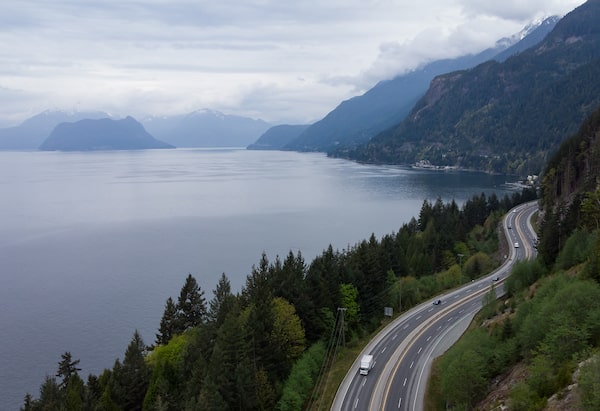
Motorists travel on the Sea-to-Sky highway between Horseshoe Bay and Lions Bay, B.C., on April 23, 2021.DARRYL DYCK/The Canadian Press
I’m writing this week from the Sechelt Inlet, a deep fjord on the coast of southwest British Columbia, about two hours from Vancouver.
As I look out the window, a light breeze riffles the grey waters. Harbour seals poke their heads above the surface to have a look around. Kids play on the beach as the tide recedes, calling out to their parents when they find some new shell or sea creature. In the distance, hazy mountains loom, one silhouette overlapping another.
This is the latest stop on a cross-country odyssey that began on July 28, when my wife and I packed up the car in Toronto and set out for the West Coast to visit her sister in the Gulf Islands. We’ve covered 4,739 kilometres so far, stopping in Thessalon, Thunder Bay, Winnipeg, Moose Jaw, Drumheller, Calgary, Revelstoke and Kelowna.
What a journey. What a country. Canada is incredible – not just in the usual, modern sense (magnificent, wonderful, marvellous, spectacular) but in the original one: impossible to believe.
It’s impossible to believe the sheer size and natural variety of this country. We’ve passed through the wild north shore of Lake Superior, crossing the countless rivers and streams that spill into that great inland sea; the vast boreal forest in northwest Ontario; the still vaster prairies, green and gold in their mid-summer splendour; then the Rockies, where we hiked through an alpine meadow bursting with paintbrush and arctic lupine and along a famous gorge, Johnston Canyon, filled with roaring waterfalls.
It’s impossible to believe that the country’s first European explorers and settlers managed to navigate such an expanse.
In Fort William, the reconstructed trading post on the banks of the Kaministiquia River in Thunder Bay, you can see new-made versions of the big freight canoes that travelled up from Montreal to fetch precious furs from the Northwest, a gruelling feat of pure shoulder power. On a wall is a map of the region by the brilliant mapmaker David Thompson, the one-eyed explorer with a bad leg who trekked or paddled 80,000 kilometres in his lifetime. None of it would have been possible without that magical Indigenous invention, the canoe.
At Craigellachie, near Eagle Pass in British Columbia, we visited the spot where white-bearded Donald Smith drove the last spike in the Canadian Pacific Railway on the morning of Nov. 7, 1885 (his aim was off and he bent the spike on his first try). Just finding a way through the Rockies was an epic task. That, too, was only achieved with Indigenous knowledge. The rail line itself is an engineering triumph, wending its way to the sea through dark tunnels and across towering trestle bridges. Thousands of cruelly exploited Chinese labourers helped complete the task.
It’s impossible to believe the human variety of this country, too. Heading west out of Thunder Bay, we passed a series of towns with Finnish names, a legacy of waves of immigration from Finland in the late 19th and early 20th century. In the prairie provinces, Ukrainians and Germans made their mark.
Today, new waves of newcomers are enriching the country. In Manitoba, the language most commonly spoken at home, after English, is now Tagalog, the language of the Philippines. Next door in Saskatchewan, downtown Moose Jaw boasts the Kabayan Sari-sari store, featuring Filipino and other foods, including pad thai and Korean corn dogs.
In Maryfield, Sask., a prairie hamlet where my uncle grew up during the Great Depression, the owner of the only corner store is a woman from South Korea who used to run similar shops in Vancouver and Prince George. She told me she had always liked the idea of living in a small town. So when she saw the store for sale on the Internet, she picked up and moved all the way to Maryfield. Her son is an emergency doctor in Toronto.
In Revelstoke, B.C., we met a Czech woman who sells artisanal chocolate at the farmer’s market. She came to Canada to see its glories and never went home. Down the street, a restaurant offers an original combination: East Indian and German food.
What a miracle that people with such different origins can live together under one national roof with so little friction. On the ground, where it counts, our multicultural experiment is working.
Canada has its troubles, all right. Souring politics, raging inflation, sagging house prices, a strained health system. It has its sins, too, past and present. Wrestling this country into existence took a terrible toll on its environment and its original inhabitants.
But how lucky we are to have it. There is nothing like a trip across the country to affirm your faith in Canada, the impossible country.
Keep your Opinions sharp and informed. Get the Opinion newsletter. Sign up today.
 Marcus Gee
Marcus Gee